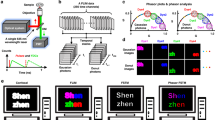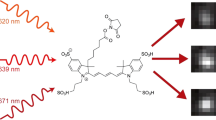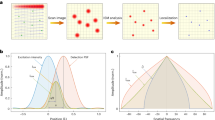Abstract
Direct stochastic optical reconstruction microscopy (dSTORM) uses conventional fluorescent probes such as labeled antibodies or chemical tags for subdiffraction resolution fluorescence imaging with a lateral resolution of ∼20 nm. In contrast to photoactivated localization microscopy (PALM) with photoactivatable fluorescent proteins, dSTORM experiments start with bright fluorescent samples in which the fluorophores have to be transferred to a stable and reversible OFF state. The OFF state has a lifetime in the range of 100 milliseconds to several seconds after irradiation with light intensities low enough to ensure minimal photodestruction. Either spontaneously or photoinduced on irradiation with a second laser wavelength, a sparse subset of fluorophores is reactivated and their positions are precisely determined. Repetitive activation, localization and deactivation allow a temporal separation of spatially unresolved structures in a reconstructed image. Here we present a step-by-step protocol for dSTORM imaging in fixed and living cells on a wide-field fluorescence microscope, with standard fluorescent probes focusing especially on the photoinduced fine adjustment of the ratio of fluorophores residing in the ON and OFF states. Furthermore, we discuss labeling strategies, acquisition parameters, and temporal and spatial resolution. The ultimate step of data acquisition and data processing can be performed in seconds to minutes.
This is a preview of subscription content, access via your institution
Access options
Subscribe to this journal
Receive 12 print issues and online access
$259.00 per year
only $21.58 per issue
Buy this article
- Purchase on SpringerLink
- Instant access to full article PDF
Prices may be subject to local taxes which are calculated during checkout






Similar content being viewed by others
References
Abbe, E. Beiträge zur Theorie des Mikroskops und der mikroskopischen Wahrnehmung. Arch. Mikrosk. Anat. 9, 413–487 (1873).
Born, M. & Wolf, E. Principles of Optics: Electromagnetic Theory of Propagation, Interference and Diffraction of Light (Cambridge University Press, 1997).
Betzig, E. & Trautman, J.K. Near-field optics: microscopy, spectroscopy, and surface modification beyond the diffraction limit. Science 257, 189–195 (1992).
Hell, S. & Stelzer, E.H.K. Fundamental improvement of resolution with a 4Pi-confocal fluorescence microscope using two-photon excitation. Opt. Commun. 93, 277–282 (1992).
Hell, S.W. & Wichmann, J. Breaking the diffraction resolution limit by stimulated emission: stimulated-emission-depletion fluorescence microscopy. Opt. Lett. 19, 780–782 (1994).
Hell, SW. Far-field optical nanoscopy. Science 316, 1153–1158 (2007).
Gustafsson, M.G. Surpassing the lateral resolution limit by a factor of two using structured illumination microscopy. J. Microsc. 198, 82–87 (2000).
Kner, P., Chhun, B.B., Griffis, E.R., Winoto, L. & Gustafsson, M.G. Super-resolution video microscopy of live cells by structured illumination. Nat. Methods 6, 339–342 (2009).
Bobroff, N. Position measurement with a resolution and noise limited instrument. Rev. Sci. Instrum. 57, 1152–1157 (1986).
Betzig, E. Proposed method for molecular optical imaging. Opt. Lett. 20, 237–239 (1995).
Bornfleth, H., Sätzler, K., Eils, R. & Cremer, C. High-precision distance measurements and volume-conserving segmentation of objects near and below the resolution limit in three-dimensional confocal fluorescence microscopy. J. Microsc. 189, 118–136 (1998).
Lacoste, Th.D. et al. Ultrahigh-resolution multicolour colocalization of single fluorescent probes. Proc. Natl Acad. Sci. USA 97, 9461–9466 (2000).
Heilemann, M. et al. High-resolution colocalization of single dye molecules by fluorescence lifetime imaging microscopy. Anal. Chem. 74, 3511–3517 (2002).
Thompson, R.E., Larson, D.R. & Webb, W.W. Precise nanometer localization analysis for individual fluorescent probes. Biophys. J. 82, 2775–2783 (2002).
Yildiz, A. et al. Myosin V walks hand-over-hand: single fluorophore imaging with 1.5-nm localization. Science 300, 2061–2065 (2003).
Qu, X., Wu, D., Mets, L. & Scherer, N.F. Nanometer-localized multiple single-molecule fluorescene microscopy. Proc. Natl Acad. Sci. USA 101, 11298–11303 (2004).
Lidke, K.A., Rieger, B., Jovin, T.M. & Heintzmann, R. Superresolution by localization of quantum dots using blinking statistics. Opt. Exp. 13, 7052–7062 (2005).
Betzig, E. et al. Imaging intracellular fluorescent proteins at nanometer resolution. Science 313, 1642–1645 (2006).
Hess, S.T., Girirajan, T.P. & Mason, M.D. Ultra-high resolution imaging by fluorescence photoactivation localization microscopy. Biophys. J. 91, 4258–4272 (2006).
Rust, M.J., Bates, B. & Zhuang, X. Sub-diffraction-limit imaging by stochastic optical reconstruction microscopy (STORM). Nat. Methods 3, 793–795 (2006).
Heilemann, M. et al. Subdiffraction-resolution fluorescence imaging with conventional fluorescent probes. Angew. Chem. Int. Ed. 47, 6172–6176 (2008).
Heilemann, M., van de Linde, S., Mukherjee, A. & Sauer, M. Super-resolution imaging with small organic fluorophores. Angew. Chem. Int. Ed. 48, 6903–6908 (2009).
Lemmer, P. et al. SPDM: light microscopy with single-molecule resolution at the nanoscale. Appl. Phys. B 93, 1–12 (2008).
Baddeley, D. et al. Light-induced dark states of organic fluochromes enable 30 nm resolution imaging in standard media. Biophys. J. 96, L22–L24 (2009).
Gunkel, M. et al. Dual color localization microscopy of cellular nanostructures. Biotechnol. J. 4, 927–938 (2009).
Fölling, J. et al. Fluorescence nanoscopy by ground-state depletion and single-molecule return. Nat. Methods 5, 943–945 (2008).
Steinhauer, C., Forthmann, C., Vogelsang, J. & Tinnefeld, P. Superresolution microscopy on the basis of engineered dark states. J. Am. Chem. Soc. 130, 16840–16841 (2008).
Vogelsang, J., Cordes, T., Forthmann, C., Steinhauer, C. & Tinnefeld, P. Controlling the fluorescence of ordinary oxazine dyes for single-molecule switching and superresolution microscopy. Proc. Natl Acad. Sci. USA 106, 8107–8112 (2009).
Dertinger, T., Colyer, R., Iyer, G., Weiss, S. & Enderlein, J. Fast background-free 3D superresolution optical fluctuation imaging (SOFI). Proc. Natl Acad. Sci. USA 106, 22287–22292 (2009).
Dertinger, T., Heilemann, M., Vogel, R., Sauer, M. & Weiss, S. Super-resolution optical fluctuation imaging with organic dyes. Angew. Chem. Int. Ed. 49, 9441–9443 (2010).
Flors, C. et al. A stroboscopic approach for fast photoactivation-localization microscopy with dronpa mutants. J. Am. Chem. Soc. 129, 13970–13977 (2007).
Flors, C., Ravarani, C.N. & Dryden, D.T. Super-resolution imaging of DNA labeled with intercalating dyes. Chemphyschem 10, 2201–2204 (2009).
Gould, T.J., Verkhusha, V.V. & Hess, S.T. Imaging biological structures with fluorescence photoactivation localization microscopy. Nat. Protoc. 4, 291–308 (2009).
Shroff, H., White, H. & Betzig, E. Photoactivation localization microscopy (PALM) of adhesion complexes. Curr. Protoc. Cell Biol. 41, 4.21.1–4.21.27 (2008).
Ji, N., Shroff, H., Zhong, H & Betzig, E. Advances in the speed and resolution of light microscopy. Curr. Opin. Neurobiol. 18, 605–616 (2008).
Hell, S.W. Microscopy and its focal switch. Nat. Methods 6, 24–32 (2009).
Huang, B., Bates, M. & Zhuang, X. Super-resolution fluorescence microscopy. Annu. Rev. Biochem. 78, 993–1016 (2009).
Heilemann, M. Fluorescence microscopy beyond the diffraction limit. J. Biotechnol. 149, 243–251 (2010).
Lippincott-Schwartz, J. & Patterson, G.H. Fluorescent proteins: a cell biologist's user guide. Methods Cell Biol. 85, 45–61 (2008).
Shroff, H., Galbraith, C.G., Galbraith, J.A. & Betzig, E. Live-cell photoactivated localization microscopy of nanoscale adhesion dynamics. Nat. Methods 5, 417–423 (2008).
Manley, S. et al. High-density mapping of single-molecule trajectories with photoactivated localization microscopy. Nat. Methods 5, 155–157 (2008).
Ormo, M. et al. Crystal structure of the Aequorea Victoria green fluorescent protein. Science 273, 1392–1395 (1996).
Shannon, C.E. Communication in the presence of noise. Proc. Inst. Radio Eng. 37, 10–21 (1949).
Shaner, N.C. Improving the photostability of bright monomeric orange and red fluorescent proteins. Nat. Methods 5, 545–551 (2008).
Tang, J., Akerboom, J., Vaziri, A., Looger, L.L. & Shank, S.V. Near-isotropic 3D optical nanoscopy with photon-limited chromophores. Proc. Natl Acad. Sci. USA 107, 10068–10073 (2010).
van de Linde, S., Sauer, M. & Heilemann, M. Subdiffraction-resolution fluorescence imaging of proteins in the inner mitochondrial membrane with photoswitchable fluorophores. J. Struct. Biol. 164, 250–254 (2008).
van de Linde, S., Kasper, R., Heilemann, M. & Sauer, M. Photoswitching microscopy with standard fluorophores. Appl. Phys. B. 93, 725–731 (2008).
Heilemann, M., Dedecker, P., Hofkens, J. & Sauer, M. Photoswitches: key molecules for subdiffraction-resolution fluorescecne imaging and molecular quantification. Laser Photon. Rev. 3, 180–202 (2009).
van de Linde, S. et al. Multicolor photoswitching microscopy for subdiffraction-resolution fluorescence imaging. Photochem. Photobiol. Sci. 8, 465–469 (2009).
Owen, D.M. et al. PALM imaging and cluster analysis of protein heterogeneity at the cell surface. J. Biophotonics 3, 446–454 (2009).
Endesfelder, U., van de Linde, S., Wolter, S., Sauer, M. & Heilemann, M. Subdiffraction-resolution fluorescence microscopy of myosin-actin motility. Chemphyschem 11, 836–840 (2010).
Wombacher, R. et al. Live cell super-resolution imaging with trimethoprim conjugates. Nat. Methods 7, 717–719 (2010).
Klein, T. et al. Live-cell dSTORM with SNAP-tag fusion proteins. Nat. Methods 8, 7–9 (2011).
Wolter, S. et al. Real-time computation of subdiffraction-resolution fluorescence images,. J. Microsc. 237, 12–22 (2010).
Beaumont, P.C., Johnson, D.G. & Parsons, B.J. Excited state and free radical properties of rhodamine dyes in aqueous solution: a laser flash photolysis and pulse radiolysis study. J. Photochem. Photobiol. 107, 175–183 (1997).
Doose, S., Neuweiler, H. & Sauer, M. Fluorescence quenching by photoinduced electron transfer: a reporter for conformational dynamics of macromolecules. Chemphyschem 10, 1389–1398 (2009).
Görner, H. Oxygen uptake induced by electron transfer from donors to the triplet state of methylene blue and xanthene dyes in air-saturated aqueous solution. Photochem. Photobiol. Sci. 7, 371–376 (2008).
Burner, U., Jantschko, W. & Obinger, C. Kinetics of oxidation of aliphatic and aromatic thiols by myeloperoxidase compounds I and II. FEBS Lett. 443, 290–296 (1999).
Burner, U. & Obinger, C. Transient-state and steady-state kinetics of the oxidation of aliphatic and aromatic thiols by horseradish peroxidase. FEBS Lett. 411, 269–274 (1997).
Madej, E. & Wardman, P. The oxidizing power of the glutathione thiyl radical as measured by its electrode potential at physiological pH. Arch. Biochem. Biophys. 462, 94–102 (2007).
Wardmann, P. Reduction potentials of one-electron couples involving free radicals in aqueous solution. J. Phys. Chem. Ref. Data 18, 1637–1755 (1989).
van de Linde, S. et al. Photoinduced formation of reversible dye radicals and their impact on super-resolution imaging. Photochem. Photobiol. Sci. 10, 499–506 (2011).
Michaelis, L., Schubert, M.P. & Granick, S. Semiquinone radicals of thiazines. J. Am. Chem. Soc. 62, 204–211 (1940).
Heineken, F.W., Bruin, M. & Bruin, F. ESR investigation of some thiazine and oxazine dye radicals. J. Chem Phys. 37, 1479–1482 (1962).
Kottke, T., van de Linde, S., Sauer, M., Kakorin, S. & Heilemann, M. Identification of the product of photoswitching of an oxazine fluorophore using FT-IR difference spectroscopy. J. Phys. Chem. Lett. 1, 3156–3159 (2010).
Sies, H. Glutathione and its role in cellular functions. Free Radic. Biol. Med. 27, 916–921 (1999).
Benesch, R.E. & Benesch, R. Enzymatic removal of oxygen for polarography and related methods. Science 118, 447–448 (1953).
Rasnik, I., McKinney, S.A. & Ha, T. Nonblinking and long-lasting single-molecule fluorescence imaging. Nat. Methods 3, 891–893 (2006).
Lenhard, J.R. & Cameron, A.D. Electrochemistry and electronic spectra of cyanine dye radicals in acetonitrile. J. Phys. Chem. 97, 4916–4925 (1993).
Dempsey, G.T. et al. Photoswitching mechanism of cyanine dyes. J. Am. Chem. Soc. 131, 18192–18193 (2009).
Lord, S.J. et al. A photoactivatable push-pull fluorophore for single-molecule imaging in live cells. J. Am. Chem. Soc. 130, 9204–9205 (2008).
Lee, H.D. et al. Superresolution imaging of targeted proteins in fixed and living cells using photoactivatable organic fluorophores. J. Am. Chem. Soc. 132, 15099–15101 (2010).
Fölling, J. et al. Photochromic rhodamines provide nanoscopy with optical sectioning. Angew. Chem. Int. Ed. 46, 6266–6270 (2007).
Bossi, M. et al. Multicolor far-field fluorescence nanoscopy through isolated detection of distinct molecular species. Nano Lett. 8, 2463–2468 (2008).
van de Linde, S., Wolter, S., Heilemann, M. & Sauer, M. The effect of photoswitching kinetics and labeling densities on super-resolution fluorescence imaging. J. Biotechnol. 149, 260–266 (2010).
Cordes, T. et al. Resolving single-molecule assembled patterns with superresolution blink-microscopy. Nano Lett. 10, 645–651 (2010).
Vogelsang, J. et al. Make them blink: probes for super-resolution microscopy. Chemphyschem 11, 2475–2490 (2010).
Tokunaga, M., Imamoto, N. & Sakata-Sogawa, K. Highly inclined thin illumination enables clear single-molecule imaging in cells. Nat. Methods 5, 159–161 (2008).
Pavani, S.R. et al. Three-dimensional, single-molecule fluorescence imaging beyond the diffraction limit by using a double-helix point spread function. Proc. Natl Acad. Sci. USA 106, 2995–2999 (2009).
Shtengel, G. et al. Interferometric fluorescent super-resolution microscopy resolves 3D cellular ultrastructure. Proc. Natl Acad. Sci. USA 106, 3125–3130 (2009).
Juette, M.F. et al. Three-dimensional sub-100 nm resolution fluorescecne microscopy of thick samples. Nat. Methods 5, 527–529 (2008).
Huang, B., Wang, W.Q., Bates, M. & Zhuang, X.W. Three-dimensional super-resolution imaging by stochastic optical reconstruction microscopy. Science 319, 810–813 (2008).
Neubeck, A. & van Gool, L. Efficient non-maximum suppression. in ICPR '06: Proceedings of the 18th International Conference on Pattern Recognition. Hong Kong, pp 850–855 (IEEE Computer Society, 2006).
Galassi, M. et al. Gnu Scientific Library: Reference Manual (Network Theory, 2003).
Yaroslavsky, L.P. Digital Picture Processing. (Springer, 1985).
Thomann, D., Dorn, J., Sorger, P.K. & Danuser, G. Automatic fluorescent tag localization II: improvement in super-resolution by relative tracking. J. Microsc. 211, 230–248 (2003).
Hess, S.T. et al. Dynamic clustered distribution of hemaglutinin resolved at 40 nm in living cell membranes discriminates between raft theories. Proc. Natl Acad. Sci. USA 104, 17370–17375 (2007).
Zhang, J., Campbell, R.E., Ting, A.Y. & Tsien, R.Y. Creating new fluorescent probes for cell biology. Nat. Rev. Mol. Cell Biol. 3, 906–918 (2002).
Lippincott-Schwartz, J. & Patterson, G.H. Development and use of fluorescent protein markers in living cells. Science 300, 87–91 (2003).
Miyawaki, A., Sawano, A. & Kogure, T. Lighting up cells: labelling proteins with fluorophores. Nat. Cell Biol. 5, S1–S7 (2003).
Riedl, J. et al. Lifeact: a versatile marker to visualize F-actin. Nat. Methods 5, 605–607 (2008).
Griffin, B.A., Adams, S.R. & Tsien, R.Y. Specific covalent labeling of recombinant protein molecules inside live cells. Science 281, 269–272 (1998).
Keppler, A. et al. A general method for the covalent labeling of fusion proteins with small molecules in vivo. Nat. Biotechnol. 21, 86–89 (2003).
Keppler, A., Pick, H., Arrivoli, C., Vogel, H. & Johnsson, K. Labelling of fusion proteins with synthetic fluorophores in live cells. Proc. Natl Acad. Sci. USA 101, 9955–9959 (2004).
Los, G.V. et al. HaloTag: a novel protein labeling technology for cell imaging and protein analysis. ACS Chem. Biol. 3, 373–382 (2008).
Miller, L.W. & Cornish, V.W. Selective chemical labeling of proteins in living cells. Curr. Opin. Chem. Biol. 9, 56–61 (2005).
Miller, L.W., Cai, Y., Sheetz, M.P. & Cornish, V.W. In vivo protein labelling with trimethoprim conjugates: a flexible chemical tag. Nat. Methods 2, 255–257 (2005).
Gallagher, S. et al. An in vivo covalent TMP-tag based on proximity-induced reactivity. ACS Chem. Biol. 7, 547–556 (2009).
Michalet, X. et al. Quantum dots for live cells, in vivo imaging, and diagnostics. Science 307, 538–544 (2005).
Robinson, R.W. & Snyder, J.A. An innovative fixative for cytoskeletal components allows high resolution in colocalization studies using immunofluorescence techniques. Histochem. Cell. Biol. 122, 1–5 (2004).
Vogelsang, J. et al. A reducing and oxidizing system minimizes photobleaching and blinking of fluorescent dyes. Angew. Chem. Int. Ed. 47, 5465–5469 (2008).
Acknowledgements
We gratefully acknowledge support from G. Wiebusch, B. Vogel, U. Endesfelder, T. Holm and S. Proppert. We thank V.W. Cornish and R. Wombacher for providing the TMP substrates and the H2B-eDHFR plasmid. This work was supported by the Biophotonics and the Systems Biology Initiative (FORSYS) of the German Ministry of Research and Education (BMBF).
Author information
Authors and Affiliations
Contributions
S.v.d.L., A.L., T.K., M. Heidbreder, S.W., M. Heilemann and M.S. conceived and designed the experiments; S.v.d.L., A.L., T.K., M. Heidbreder and S.W. performed the experiments; M. Heilemann and M.S. supervised the project; and M. Heilemann, S.v.d.L. and M.S. wrote the paper.
Corresponding author
Ethics declarations
Competing interests
The authors declare no competing financial interests.
Rights and permissions
About this article
Cite this article
van de Linde, S., Löschberger, A., Klein, T. et al. Direct stochastic optical reconstruction microscopy with standard fluorescent probes. Nat Protoc 6, 991–1009 (2011). https://doi.org/10.1038/nprot.2011.336
Published:
Issue Date:
DOI: https://doi.org/10.1038/nprot.2011.336
This article is cited by
-
Blinking characteristics of organic fluorophores for blink-based multiplexing
Communications Chemistry (2024)
-
Quantitatively mapping local quality of super-resolution microscopy by rolling Fourier ring correlation
Light: Science & Applications (2023)
-
Event-based vision sensor for fast and dense single-molecule localization microscopy
Nature Photonics (2023)
-
Temporally resolved SMLM (with large PAR shift) enabled visualization of dynamic HA cluster formation and migration in a live cell
Scientific Reports (2023)
-
Impaired FADD/BID signaling mediates cross-resistance to immunotherapy in Multiple Myeloma
Communications Biology (2023)



